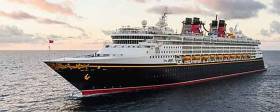Displaying items by tag: Disney Cruise Line
Double the Disney Magic for Cork in 2018 As Season to Total 100 Cruiseships
#cruiseliners - Earlier in the year Disney Cruise Line announced the Port of Cork on their list of first time visits in 2018.
Following successful port visits and further dialogue, today Disney Cruise Line have doubled the Magic coming to Cork with two visits of the ‘Disney Magic’ confirmed for Cork in 2018.
But the excitement doesn’t stop there. The Port of Cork can also reveal that they have hit 100 cruise liner calls for 2018, showing a staggering 30% increase in the cruise business to Cork.
Commercial Manager, Captain Michael McCarthy Port of Cork said: ‘Our cruise bookings have been hovering around 97 and 98 calls in the last month, and to finally hit the 100 mark is truly fantastic for the port and the region. Not only expecting 100 cruise lines next year, but confirmation of two calls by Disney Cruise Line is really big news for Cork.’
He continued: ‘It goes without saying that over the last two years the Port of Cork has worked incredibly hard to secure these cruise bookings and we are confident this growth can continue.’
The 2017 cruise season is shortly coming to an end with only two cruise liners left to call. In total 68 cruise liners called this year with 140,000 passengers and crew on board. This year also saw Cobh once again being ranked second favourite cruise destination in the British Isles and Western Europe in the 2017 Cruise Critic Cruisers’ Choice Destination Awards.
Cruise Critic is the world's leading cruise review site and online cruise community and the awards name the best cruise destinations of the year – across 15 regions around the world – based entirely on reviews posted by cruise passengers to the Cruise Critic website.
Capt McCarthy said: ‘As always this is a genuine collaborative team effort and it could not be done without an extremely dedicated group of people who believe in our destination. Once the liner arrives, together with Cork City Council we offer tourism ambassadors on every liner, local entertainment and then as their visit ends, we have the Cobh Brass band on the quayside as the liner departs. This all helps in making a visit to a port memorable and positive.’
‘We are very fortunate in Cork City and County that there is an abundance of tourist attractions for cruise passengers to visit which are all easily accessible from the port. It is these experiences that have ensured Cobh remains in the top five cruise destinations in Western Europe.’
Disney Cruise Line is Coming to Cork Harbour in 2018
Disney Cruise Line has revealed its summer 2018 itinerary includes the Port of Cork on their list of first time visits.
2017 is already being described as one of the busiest cruise seasons in Cork with 69 cruise liners calling to the port.
The ‘Disney Magic’ will travel to Cork Harbour for the first time as part of Disney Cruise Line’s new seven-night British Isles cruise, departing in September 2018.
Announcing the first time call, Disney Cruise Line described Cork as ‘home to a vibrant culinary scene and a plethora of pubs, shops and cafes. It invites visitors to connect with Ireland’s ancient past, with historic sites like Blarney Castle, where visitors can kiss the famed Blarney Stone.’
Captain Michael McCarthy, Commercial Manager Port of Cork said: ‘After years of marketing the region and port capabilities, we are delighted to say the hard work has paid off and we are very excited to welcome Disney Cruise Line to our port in 2018. I have no doubt this call will be one of many into the future as we grow our relationship with Disney Cruise Line.’
Capable of holding over 3,700 passengers and crew, ‘Disney Magic’ is designed with primarily the family in mind. According to Disney Cruise Line the Disney Magic combines classic nostalgia and modern amenities with Disney’s signature service. From bow to stern, set sail for unforgettable storytelling that only Disney could bring to life.
Captain McCarthy continued: ‘this is a wonderful opportunity for the region particularly family attractions that are set to benefit from such cruise visits.’
Disney’s 'Magic' Due to Make A Dublin Debut
#DisneyDublin - Disney Magic is to be one of the highlights of Dublin Port's cruise season and as the first Irish port to welcome Disney Cruise Line, a subsidiary of the famous Walt Disney Company, writes Jehan Ashmore.
As previously reported on Afloat.ie, the call next Thursday of the 300m long Disney Magic, only 33 short of the port's record holder MSC Splendida, will have 3,650 people on board visiting the capital. The 84,000 tonnes cruiseship has a 2,700 passenger capacity and they are accommodated in 875 staterooms. In total there are 11 public decks and a crew of 950.
The call by Disney will represent further confidence by the sector in choosing to make Dublin Port a destination in a season scheduled to bring 180,000 visitors from 113 calls. Of those calls four are turnaround cruises, where cruise-goers travel to the capital to begin their cruise.
The cruiseship was built in 1998 by the Italian yard of Fincantieri and the then newbuild was homeported in Port Canaveral, Florida until transferred to Europe almost a decade ago in 2007.
This led Disney Magic to make a repositioning voyage across the Atlantic Ocean and beyond when based out of Barcelona to embark inaugural cruises in the Mediterranean.
Disney Magic has an appearance that clearly echoes to the era of the trans-Atlanctic liners.
The design of having two funnels and painted in red and topped in black pays homage to liners like Normandie, France (see, large containership/longsest cruiseship). This iconic liner latter became converted into a cruiseship as the Norway, that anchored off Dun Laoghaire in the mid-1990’s.

























































